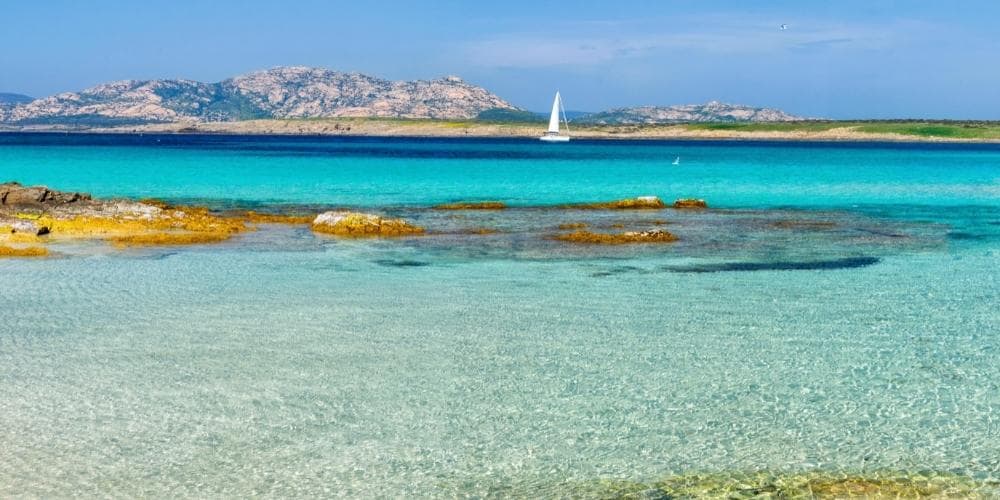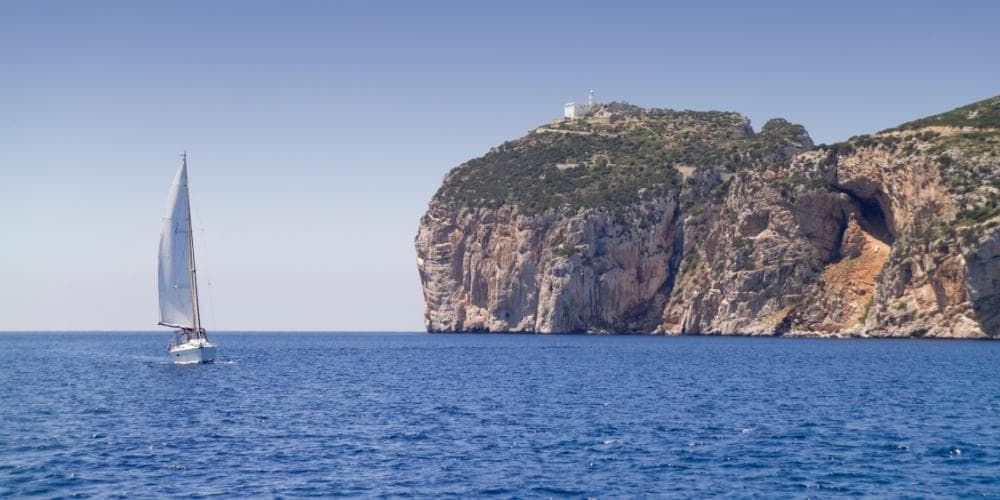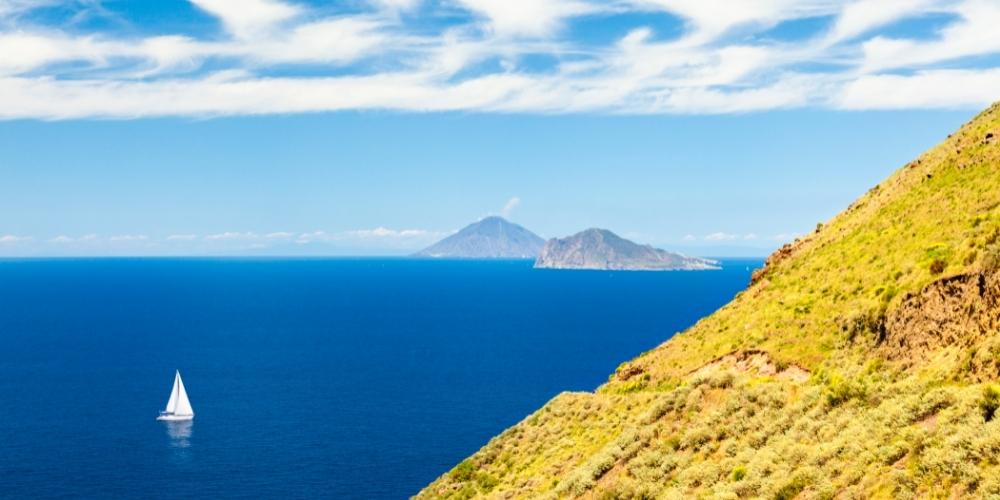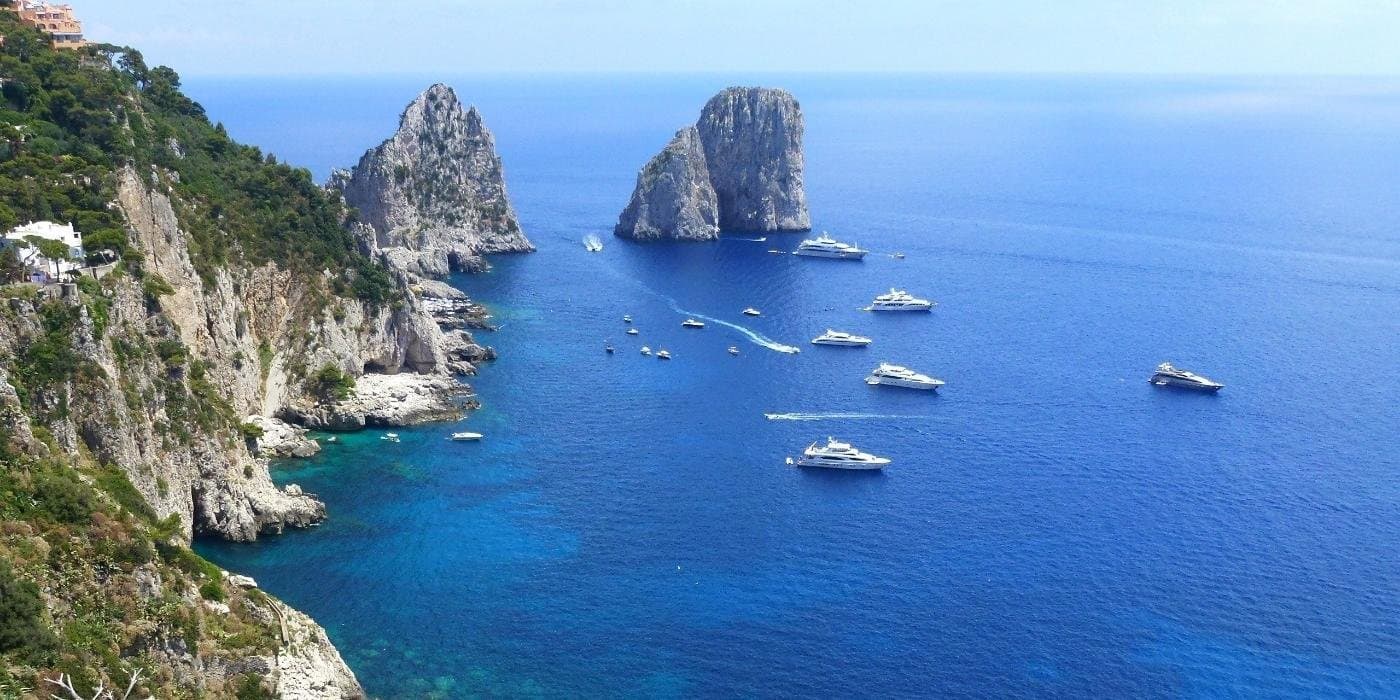The Italian coasts and islands are full of dream beaches, some of which can only be reached by sea. A holiday on a sailing yacht or a catamaran is the best way to enjoy all the wonders that a place offers, even the most hidden ones, in total luxury, relaxation, carefree and freedom. What could be better than a barefoot holiday, where the days start with a swim in crystal-clear waters and end with a starry sky as a ceiling?
Here are 5 tours (from the longest to the shortest) to discover Italy's most beautiful bays and islands. And if you don't have a suitable boat, don't worry: there are many charter companies. You can rent a boat or organise the best sailing trips with a skipper and crew!

We are the uninterrupted kingdom of the mastic tree, the waves rushing over ancient granite, the dog rose, the wind, and the immensity of the sea. We are an ancient land of long silences, wide and pure horizons, bleak plants, and mountains burnt by the sun and revenge. We are Sardinian.
5. Sailing in Sardinia: periplus of the island by catamaran, yacht or sailing boat. Duration: 10-14

Sardinia is an island famous for the beauty of its sea and because it is home to some of Italy's most beautiful beaches. It is a magical place where the Mistral wind carries ancient legends; it is a place that smells of the saltiness of the waves, of sunburnt earth, lentisk and helichrysum. As you circumnavigate this land, you will find ever-changing panoramas, some even surreal. Unspoilt, wild places and pretty towns with marinas where you can refuel your boats await you.
We start in Alghero, the capital of the Coral Riviera in the northwest of the island. The city has a well-equipped harbour for up to 2500 boats, including yachts and superyachts, which find their ideal space at the foot of the ancient walls at Marina di S. Elmo.
From here, we set sail to discover the western coast of Sardinia, the lesser-known, far from the tourist villages and nightlife, where nature reigns supreme. Here, a deep blue sea breaks against limestone stacks and flocks of pink flamingos colour the sky. The Mistral wind blows and shapes the dunes, the wagons of the old mines lie silent, reminding us of a time that no longer exists.
Sailing along the coastline, we come across the town of Bosa with its colourful houses and then the wild island of Mal di Ventre with its often rough waters. Further south, the 133-metre-high Faraglione di Pan di Zucchero juts out of the blue opposite Porto Flavia, the gateway to the sea of the Masua mines.
The south of Sardinia is reminiscent of the most remote tropical paradises, with long white beaches and a sea bluer than the sky. Here you will find the small town of Carloforte on the island of San Pietro with its Ligurian soul and the beautiful Cala Zafferano. There is Porto Pino with some of the most beautiful beaches in Sulcis, and Villasimius, the tourist resort par excellence in the south-east.
On the east coast of Sardinia, at a certain point, the Supramonte mountains plunge into the sea with sheer cliffs. Between these heights, the golden eagle flies high in the sky, the guardian of a unique beauty that is not afraid to be excessive. This landscape awaits you between Santa Maria Navarrese and Cala Gonone. We are in the Gulf of Orosei, where Cala Luna, Cala Goloritzè and Cala Mariolu rise like a mirage protected by the white rocks behind them.
Everything changes again in the northeast, on the Costa Smeralda. The landscape becomes gentler and the sparkling nightlife of the island's most exclusive holiday destination illuminates even the darkest nights. Porto Rotondo, the Grande Pevero beach, Poltu Quatu and the world-famous Porto Cervo are three must-see destinations in the "in" part of Sardinia. In a succession of famous beaches and secluded coves, we arrive at Palau and then Santa Teresa di Gallura, on the extreme north-eastern tip of the island. The rugged coastline accompanies us to the village of Isola Rossa. Here, a granite islet, as red as the setting sun, emerges from the sea in front of the houses. The landscape gradually becomes softer and more relaxed. And everything changes again.
And so we arrive at Stintino, the extreme north-western tip of the island. The beach of La Pelosa, with its almost unreal perfection, will capture that little piece of heart that has not yet been stolen from some magical corner of Sardinia.
Last stop: Alghero. With its silent grandeur, the Capo Caccia promontory lets us know that we have reached the end of our journey.
4. Sailing boat or catamaran holiday in Liguria, Tuscany and Sardinia. Duration: 10-14 days

This paragraph proposes a sailing tour to discover some famous places and small miracles of nature in three Italian regions: Liguria, Tuscany, and Sardinia.
The Gulf of Poets is a vast and deep inlet on the coast of the Ligurian Sea. Here, at one point, a fascinating Gothic church rises from the top of a promontory, where a temple dedicated to the goddess Venus Ericina once stood. The goddess gave her name to Porto Venere, a colourful UNESCO heritage fishing village where our journey begins.
We head towards the Island of Elba, the jewel of the Tuscan Archipelago painted in the colours of the Mediterranean scrub, the villages clinging to the mountains and the blue sea. Further south, on the Island of Giglio, emerald waters frame a territory that is still 90% wild.
The time has come to cross the Tyrrhenian Sea, heading for Porto Massimo on the island of La Maddalena. The La Maddalena Archipelago rises in the northeast of Sardinia. It comprises 62 islands and islets so precious that they are part of the La Maddalena Archipelago National Park. You will soon feel that you are in a paradise where all shades of blue exist, where you can breathe in the scent of the Mediterranean maquis, saltiness and silence.
Our navigation continues towards the sparkling Santa Teresa di Gallura and then Castelsardo, a medieval village perched on a promontory dominated by the ancient castle. The town overlooks the Gulf of Asinara, an island that still retains its unspoilt landscape. For over a century, Asinara was in isolation, even more so since it became the site of a maximum-security prison.
Leaving this small world that has been able to stop time, we head towards the Coral Riviera. The Porto Conte Natural Park and the Capo Caccia - Isola Piana Protected Marine Area are the last two treasure chests of biodiversity and beauty that welcome us near the final destination of our journey: Alghero, the Spanish city of Sardinia.
3. Discovering the Aeolian Islands on a sailing boat. Duration: 7-10 days

The Aeolian Archipelago is made up of 7 volcanic islands of disarming beauty that rise up off the northern coast of Sicily; you can easily reach them from the port of Milazzo, geographically the closest point of departure from the north coast to the archipelago. Vulcano, Stromboli, Lipari, Panarea, Alicudi, Filicudi and Salina are listed as UNESCO World Heritage Sites, rugged and wild islands part of a submerged volcanic arc. They are ideal for trekking, swimming, diving and sailing, with breathtaking beaches, crystal clear waters, sensational views and two active volcanoes: Stromboli and Vulcano.
Everything in the Aeolian Islands is a spectacle. The frequent activity of the Stromboli, which launches its fiery lapilli into the sky at night, will be unforgettable. Imagine being on a boat at a safe distance from the island and enjoying the fiery lava flowing down to the sea. Do you feel the sense of wonder that the power of nature can instil? After leaving Stromboli, you can move on to Panarea, a fashionable island with amazing seascapes surrounded by beautiful tiny islands. Next stop: Salina, green, cultivated, utterly different from the previous ones and home of Malvasia wine. Then there is Lipari, the largest and most touristy of the islands with its lively harbour; then Vulcano, fascinating and wild with its characteristic smell of sulphur, Filucudi and Alicudi. Among the most beautiful sights here are the Faraglione di La Canna at Filicudi and the islet of Montenassari, whose rocky wall forms a natural pool.
Anyone who chooses the Aeolian Islands as a destination for their sailing tour should not miss the opportunity to discover the wilder side of the volcanoes and the smaller rocks. There are lots of beautiful coves, caves and inlets to explore.
2. Sailing trip to the Tremiti Islands. Duration: 5-7 days

The Tremiti Islands are the only Italian archipelago in the lower Adriatic and are part of the Puglia region. They are five small, very different islands: San Nicola and San Domino (the only two inhabited), Capraia, Cretaccio and Pianosa.
The largest, San Domino, has the only port in the archipelago. It is also the most beautiful from a landscape and naturalistic point of view. On its shores, there are fascinating caves, all of which can be visited by boat, such as the Bue Marino cave, the Grotta delle Viole and the Grotta delle Rondinelle, as well as the suggestive Faraglioni dei Pagliai. San Nicola is rich in monuments that testify to the island's history. Capraia is covered in grasses and flowers, home to a large colony of seagulls and a submerged statue of Padre Pio. Pianosa is an Integral Marine Park Reserve, so you can't get within 500 metres of the island.
The fastest way to reach the Tremiti Islands by sailboat or catamaran is from the port of Termoli or Rodi Garganico, and the best way to visit the archipelago is to circumnavigate it. Only then can you discover all its wonders from the best perspective. A myriad of small inlets and coves await you, such as the famous Cala delle Arene, Cala Matano, which drops sheer into the sea, Cala degli Inglesi, where a British smugglers' boat sank. At Cala Tamariello, it is possible to moor small boats, and Cala Tonda is a cove in the rock that looks like a small lake.
Nowhere in the world are there as many opportunities for delightful quiet as on this little island.
1. Sailing holiday in the Gulf of Naples. Duration: 2 days

The Gulf of Naples is a sublime inlet of the Tyrrhenian Sea enclosed between the Phlegrean peninsula and the Sorrento peninsula. Here, there are some islands in these waters, including Capri, Ischia, and Procida.
Our itinerary starts from the tourist port of Sorrento, which has a strategic position in the Gulf of Naples. Just a few nautical miles away are the main attractions of the Sorrento - Amalfi coastline and the Archipelago of Campania. Sorrento has a unique charm that bears the signs of centuries lived under the influence of different cultures: Greeks, Romans, Normans and Aragonese. The result seems like a dream made up of such beauty and poignant landscapes, born on one of the world's most beautiful stretches of coastline.
The time has come to set sail for Capri. Charles Dickens wrote: "Nowhere in the world are there so many occasions of delightful quiet as on this little island". And this is still true today. We recommend circumnavigating the island to look at the Faraglioni, Tiberius's Leap (a sheer drop into the sea some 297 metres high), Marina Grande, Grotta Azzurra, Grotta Verde and Marina Piccola.
Leaving Capri, we head towards the island of Ischia, the largest of the Phlegraean islands in the Gulf of Naples. Ischia is famous for its thermal baths and natural springs and captivates everyone with its views and coastline of coves, inlets and bays. Some of them can only be reached by sea or by footpaths and are unmissable stops for those searching for the most exclusive spots. San Pancrazio Bay is one of the most fascinating, a paradise for snorkelers that suddenly appears among the rugged rocks of the southern coast. On the south-western side, another enchanting bay is Sorgeto, in the municipality of Forio. Here, there are natural pools on the seashore where the water has a temperature of 37 degrees. And then, on the northern side, the bay of San Montano with the Negombo thermal park.
The last stop on our tour is the island of Procida. The Italian Capital of Culture 2022 welcomes us with its charm of pastel-coloured houses, fishing boats and small bays with a crystal clear sea. Procida seems like a small world frozen in time, small enough to be walked around, less elitist than Capri and wilder than Ischia. In its inlets surrounded by high cliffs, beautiful little beaches await you, many accessible only by sea.
And it's something you can't get away from. The sea... But above all: the sea calls... It never stops, it gets inside you, it's on you, it wants you... You can pretend it's not there, but it's no use. It will continue to call you... Without explaining anything, without telling you where, there will always be a sea, calling you.
About the author
Written on 27/05/2022



Chiara Musino
Looking for the best sailing in Italy for your holiday? Here are 5 sailing tours in Italy to discover the most beautiful Italian islands and beaches.